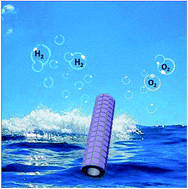A “MOFs plus MOFs” strategy toward Co–Mo2N tubes for efficient electrocatalytic overall water splitting†
Abstract
The rational combination of early-transition metal nitrides (ETMNs) with late-transition metals (LTMs) is a promising method for the design of highly efficient catalysts. Herein, we report the design of Co–Mo2N tubes based on a “MOFs plus MOFs” strategy for efficient electrocatalytic water splitting in 1 M KOH. The 1-D Mo-MOFs (Mo source) were prepared in large quantities by the reaction of imidazole with MoO3. ZIF-67 (Zeolitic Imidazolate Framework-67) (Co source) was then grown on the 1-D Mo-MOFs (Mo-based metal–organic frameworks) to obtain ZIF-67/Mo-MOFs by a solution-phase assembly method. The effective combination is due to the similarity of the ligands in the two MOFs. After nitriding, the ZIF-67 was converted into Co metal, and Mo-MOFs were converted into hollow Mo2N, thus giving a hollow Co–Mo2N hybrid with a Co outer layer on the Mo2N inner core. The ratio of Co and Mo in Co–Mo2N can be easily tuned to give optimized catalysts. The tests indicated that the combination of Co and Mo2N can significantly boost the HER performance of materials. At the current density of 10 mA cm−2, the overpotential (η10) on Co–Mo2N was only 76 mV, which is much lower than 296 mV for Mo2N derived from Mo-MOFs and 180 mV for Co–carbon from ZIF-67. The hybrid has also shown improved OER activity in comparison with Mo2N and Co; therefore, the Co–Mo2N can be used as both anode and cathode for an overall water-splitting cell with η10 of 1.576 V. The improved HER activity can be ascribed to the intimate contact between Co and Mo2N for optimized adsorption on reagents, the tube-like structure for easy mass transfer and the good conductivity of Mo2N, which is favourable for transmitting charge.



 Please wait while we load your content...
Please wait while we load your content...